Compared to the work we’ve already done disassembling the slot machine mechanism, the tear-down of the case and cabinet is a snap. Generally the terms “case” and “cabinet” and interchangeable, although the wood sides and base are the actual cabinet, while the entire assembly of wood sides, base and front castings are often considered to be the case. In any event, we need to disassemble all of the parts related to the case and cabinet. Let’s take a look.
We’re going to start by removing the escalator, which is really simple.
The escalator is essentially the part of the slot machine that accepts coins, makes sure that they are the correct denomination, rejects slugs and determines if the player is using checks. We’ll be disassembling it later, but right now we just want to remove it from the top front casting. It’s held in place by three screws denoted by arrows in the photo above. You might want to save the middle screw for last, just to keep the escalator from swinging out of place while you are removing the screws. Outside of the case, the escalator looks like this:
You occasionally see some strange things when looking at escalators. They really aren’t that tough to get working correctly, but some people are lazy. More about that later.
With the escalator removed, we can now get to a couple of pieces of glass on the front casting.
Now, removal of the frames identified above is pretty simple, but you do need to be careful with the glass when you remove the frames or else the glass will fall and break, giving you another item to replace. Often you will need to replace the glass anyway, but there’s no point in being careless. Some people prefer to leave the frames in place, remove the top casting and then deal with the frames with the casting resting flat. Honestly, that’s probably a better approach, but since I removed the frames at this point that’s what I photographed.
In the photo above you can see that someone has used strips of paper/cardboard as shims to separate the three pieces of glass from the reel windows, and this is pretty typical. Some people tape around the edge of the glass to space it out and keep it from rattling, and generally I think that’s a good idea. We’ll worry about that later, when it comes time to reassemble the case. All of the glass is pretty scratched up, and will probably need to be replaced. There’s nothing magical about the glass, and you can get any glass shop to cut you replacements for a small amount of money. If they don’t have the specific thickness you need, sandwiching a couple of pieces together to get the right thickness is a viable option.
For now, let’s wrap the various pieces of glass in paper or rags to keep it safe and move along to the removal of the top front casting.
In the photo above you can see that the top front casting is secured in six places. There are two carriage bolts on each side that secure the casting to the sides of the cabinet, plus a pair of screws/nuts that attach it to the bottom front casting. In the photo you can also see that the casting is damaged at the point where lower right carriage bolt is located. This isn’t a huge deal from the perspective of keeping the top front casting on the machine, but it’s definitely not optimal. While not a big enough flaw to justify replacing the casting, it might warrant a repair. As we delve further into the disassembly of the case and cabinet, we’re going to end up with a lot of carriage bolts, so we need to be sure to save them along with the related nuts.
There’s also another situation that I discovered while removing the top front casting, but it will be easier to see a bit further down. For now, let’s take a look at the casting after it’s been removed.
Looking at the arrows above, we can see the damage to the lower right “ear” that is supposed to receive the carriage bolt. We can also see that the two screws intended to secure the top casting to the bottom casting have been bent under rather than going through holes on the bottom casting. These will need to be cut off and replaced… no way around that. In the above photo you can also see the various screws and related hardware that secure the decorative elements found on the front of the machine to the top front casting. There’s really no point in detailing the removal of each of these elements since their removal is really straightforward… just unscrew the screws, remove the elements, and keep the screws/washers with their respective parts.
Here’s what the casting looks like from the front:
Now we need to remove the bottom front casting, which should be really simple at this point.
The bottom front casting is secured to the sub-base plate (or should be) by a couple of brackets as indicated by the arrows above. In this case, only one of the brackets is actually in place and secured to the sub-base. Also, if you look at the top of the casting to the right of the jackpot, you can see one of the places that the casting should have been connected to the top front casting by those bent-over screws, but now the story is becoming clear… the “ears” that should have received those screws are broken off. Now, I don’t know for certain, but I’m assuming that someone didn’t know what they were doing, tried to reassemble the case at some point, and just forced the top casting into place which bent the screws and broke off the ears on the bottom front casting.
Stupid, stupid, stupid.
I missed this defect when I was examining the machine before buying it, and it’s exactly the sort of thing I should have been looking for. On the brighter side, however, I was already expecting to replace this casting anyway, just because it doesn’t have the posts necessary to install a gold award dispenser. It’s very likely that the existing casting isn’t original to the machine anyway. I’ll probably have this casting repaired, if possible, for use on another machine at some point in the future.
For now, though, let’s just get the casting free. A long screwdriver can easily access the screws holding the brackets to the front casting, and once they are removed the casting should lift right out.
In the photos above, you can see several things. First, the arrows show us the various screws that secure the jackpot assembly to the casting. Removing it will be our next task. Next, we can see the broken ears we’ve been discussing to the right and left of the jackpot assembly in the second photo. There’s no point in crying about that at this point, however, so let’s remove the screws and get the jackpot free of the casting.
Well, this is technically a jackpot, but it’s missing virtually all of the important parts. This isn’t a surprise… I knew the condition of the jackpot going in. Later on we’ll be looking at the jackpot in more detail.
We left something behind when we removed the jackpot, however, and that’s another piece of glass and some related hardware. With the jackpot assembly gone, the glass and front spacer will lift right off.
Well, this is just nasty. The glass has been painted black at some point to cover the non-functional jackpot. The front piece is rusted and grimy. It also looks like someone painted at least part of the machine white at some point and didn’t bother to remove the glass or frame before doing so. The glass is a total loss, but we might be able to save the other piece.
As with the top casting, there are a few decorative pieces mounted on the bottom front casting, and these can be removed in the same manner. Just be sure to keep all the screws straight.
Next we’ll start removing the cabinet hardware.
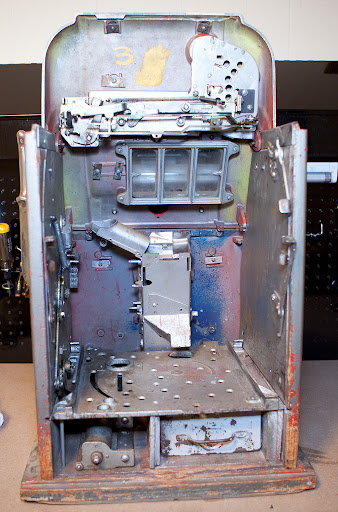
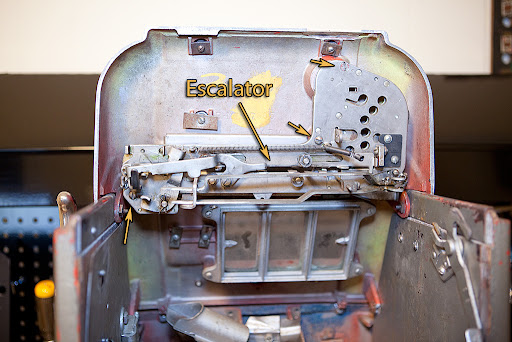

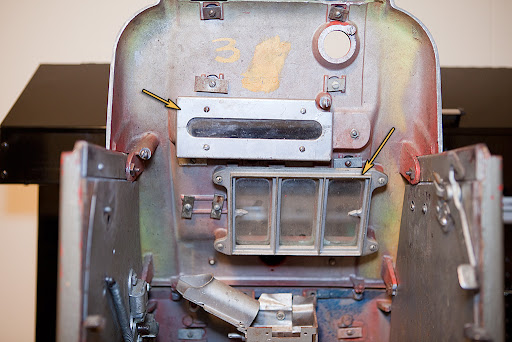
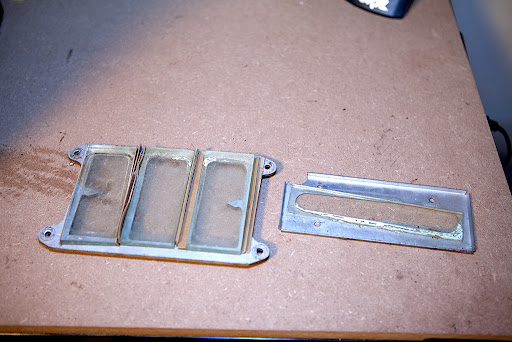

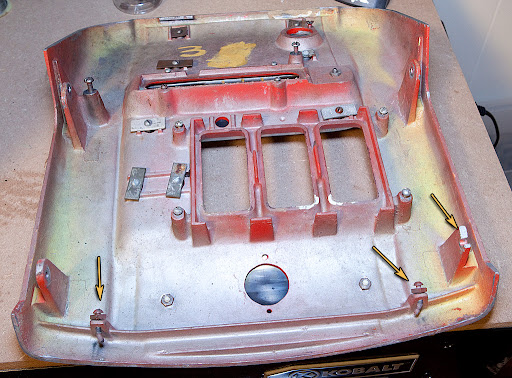


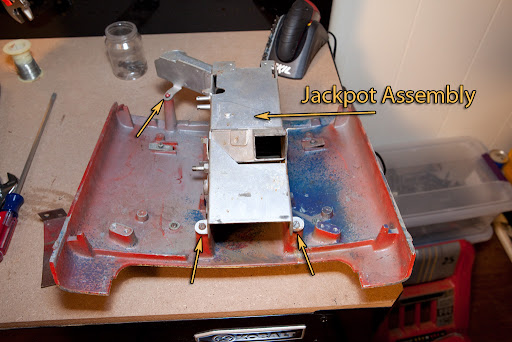

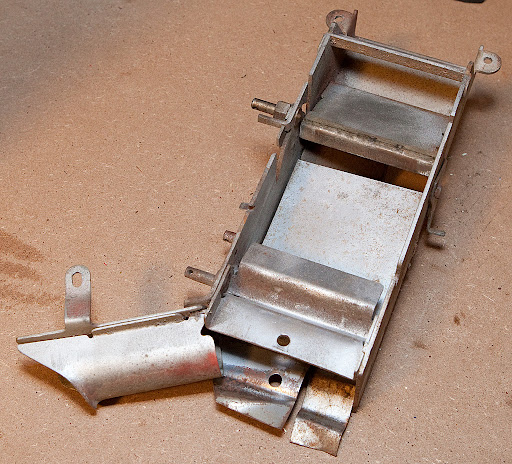
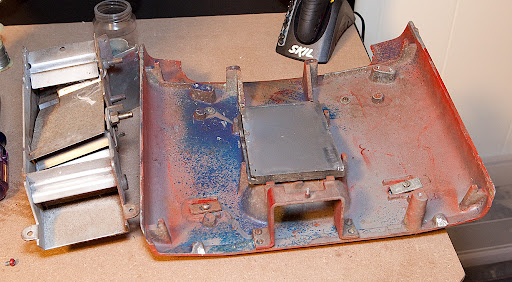
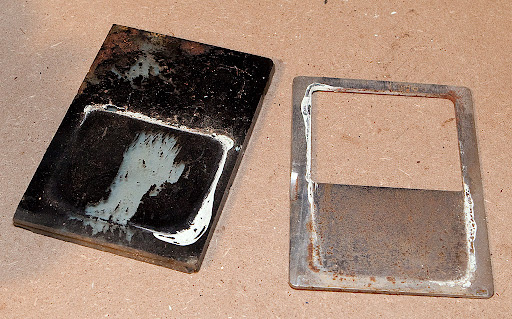
hello i just got a mills high top myself ,i think that jackpot is the reserve jackpot because your regular jackpot is the brass tube inside of the mechanism .mine was takin out and replaced with a counter that was never connected .excellent take down so far i havnt gotten that far on mine the books you speak of are very expensive im hoping to find them in a library
The brass tube is called the coin tube or the payout tube, and it handles all of the regular payouts of the slot machine. The jackpot is a separate mechanism completely, and it often (but not always) has two parts: the regular jackpot and the reserve jackpot. When a jackpot combination is hit, the regular jackpot dumps all of its coins. On the next pull of the handle, the jackpot door closes and the reserve jackpot (if present) dumps its coins into the regular jackpot so that there will be a jackpot payoff available. Next, the reserve jackpot door closes and starts to fill with coins again.
This is only true of self-filling jackpots. Hand-load jackpots have no need of a reserve.
The books are indeed somewhat expensive, but you are going to have trouble finding them in a library. They are so specialized that few if any libraries will stock them.
Keep reading along on the site, though, and you’ll probably find a lot of good information. I’m about to start cleaning and de-rusting the mechanism soon, so be sure to check back often.
Thanks for reading!
you should document by video too
im gonna keep watching your site its hard to find any restoration processes
Yeah, that’s one of the reasons that I’m doing this… there just isn’t much information on antique slot machine restoration out there on the net. I’d like to do some video as well, but just doing the photos is already really time consuming. Processing the photos and writing up the articles is taking much more time than the actual disassembly.
The video series that I mention in the references article is worth getting, too.
My jackpot window looks just as bad as yours, once i get the nerve to remove the mech. I’m going to see what it actually says behind it. I’d also love to know if it’s actually functioning on my high top owl. Very nice work again!! keep it up
Ok, I understand about the regular jackpot and the reserve jackpot, but I don’t understand how it is triggered. What part of the slot mechanism actually triggers the jackpot payout? I don’t see it in any of the photos. My jackpot has all of it’s parts as best I can tell.
The reason you don’t see that part pictured is that it was missing from this machine. When I get to the reassembly, I’ll be using a replacement part, so you should get the idea then.
OK, maybe it’s missing from mine too, because it looks pretty much like yours. Does that mean replacements are available? Thanks.
before i take the escalator apart can you tell me what to look for. the dimes do not move along and they get jammed
Well, I’m going to do a full disassembly of the escalator as soon as I get some time, but let me give you a couple of hints to tide you over. You may not need to do a full disassembly just yet.
First, take the mechanism out of your case so that it isn’t in your way and you have a good, clear view of the escalator.
Next, clear all of the coins out of the escalator. You might consider blowing the dust out of it with some compressed air as well. Honestly, this may be enough to fix the situation. Once a single coin gets off the track the escalator doesn’t work worth a damn.
Finally, move the escalator back and forth to see if it is moving smoothly. A few drops of 3-in-one oil on the friction points is probably a good idea, but use it sparingly. You don’t want oil dripping from the escalator down onto your precious reel strips.
Unless you have a worn part, this will probably get your escalator working for the time being. Eventually you will probably want to disassemble it, thoroughly clean and degrease it, and then reassemble it with fresh lubricant, but if the escalator is complete, properly put together and reasonably clean you should be able to tinker with it a bit and get it working.
Hope that helps!
This is an incredible resource – thanks for your hard work! I’m reading every word.